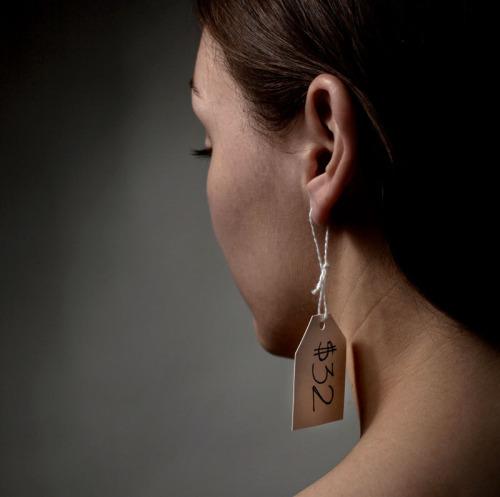 ess than 10 percent of doctors recognize trafficking victims, and less than 3 percent of ER doctors have received training in recognition and action. Here’s what we can do about it. (Photo: Getty Images)
ess than 10 percent of doctors recognize trafficking victims, and less than 3 percent of ER doctors have received training in recognition and action. Here’s what we can do about it. (Photo: Getty Images)
When his church embarked on a small project to help prevent human trafficking, Douglas Chin, MD, a surgeon in Oakland, Calif., joined the group.
In their minds human trafficking was an overseas problem. Church members began looking into ways to address gender inequity outside the country by empowering women, which experts agreed would help reduce the sex trade, strengthen global health, and lead to better economic opportunities. “We were really thinking, ‘What can we do in the United States to help international women — in Thailand, in India?” Chin tells Yahoo Health.
But then a young woman went to Chin’s office in California for a routine orthopedic problem, and he noticed something very unusual. She came with an older male figure, who spent the appointment hovering close by. She was reticent. She had tattoos on her body, and gray marks on her skin.
He later found out that the young woman was a victim of human trafficking.

“The gray marks were something called postinflammatory hyperpigmentation, which is the result of repeated trauma. The tattoos were probably indicating she was property,” Chin says. “It just hit me. At church, we were looking at this as an international problem, yet it was right here under our noses.
“A lot of these victims were likely seeking medical help. Were we just missing them?”
Trafficking in the United States
Human trafficking, for both sex and labor, is not just an international problem; it is a U.S. problem. According to estimates, roughly 1 million adults and 400,000 children are presumed to be at risk for sex trafficking annually on American soil.
It’s big business, with relatively low risk and high reward, says Holly Atkinson, MD, director of the Human Rights Program at Mount Sinai in New York City and co-chair of the American Medical Women’s Association’s, Physicians Against the Trafficking of Humans (PATH) initiative. Global revenues for human trafficking likely exceed $31 billion, according to estimates.
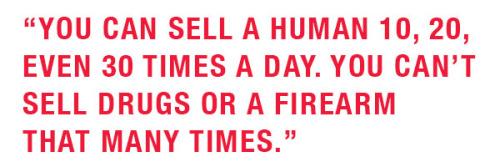
“It is so lucrative, probably only second to drug trafficking in revenue,” Atkinson tells Yahoo Health. “This is because you can sell a human 10, 20, even 30 times a day. You can’t sell drugs or a firearm that many times.”
And there is no specific profile for victims of trafficking. It can affect people of any gender, age, race or social class. Chin says that while more than 80 percent of labor-trafficking victims in the United States are brought in from foreign countries, that stat is flipped for sex-trafficking victims. “Roughly 80 percent of those victims are American-born, U.S. citizens,” says Chin. “It affects all demographics, from the affluent to the underprivileged.”
And traffickers seek victims everywhere. “One of the biggest myths is that it doesn’t happen here or that most victims are foreign-born — with sex trafficking, it’s not true,” says Atkinson. “They’re recruiting at schools, in shopping malls. They are using psychological techniques, acting as boyfriends to young girls, buying them things — and then they start to ask for things. ‘If you really loved me, you’d have sex with my friend.’”
Certain risk factors do make a person more vulnerable to that slippery slope into trafficking, though, including being from a broken home. “It is higher in specific demographics,” Atkinson says. “Among runaways, [and among] LGBT, sexually-abused and foster children.”
Related: Why We Should Ban The Word ‘Slut’
What’s difficult about trafficking is that it’s a hidden problem. You can pass victims everyday on the street and not really realize it — especially because many of the young women and men who are initially victimized and pushed into this life of captivity become attached to their captors and can’t find a way out, according to Elaine Richardson, Ph.D, a professor at the Department of Teaching and Learning at The Ohio State University and a former victim of sex trafficking.
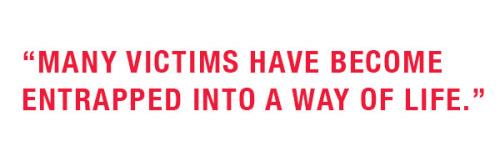
“Young victims are in middle schools, in your neighborhood, or even in your family,” she tells Yahoo Health. “Some of them are grown women, and many are not doing it just because they enjoy sex and want to get paid for it. Many victims have become entrapped into a way of life, even if they now seem to be doing it for themselves without pimps.”
Once you’re in the middle of this life, it’s hard to climb out, says Richardson. “They are still human beings who deserve to be valued as humans, who need help, support, and love,” she says.

And they might be able to find support in the places where most men, women, and even trafficking victims eventually go: clinics, doctor’s offices and hospitals. Even dentists can be essential in victim identification, says Atkinson. While ER physicians might see a victim for an acute medical problem like a broken bone or STD, dentists may see a victim for a chronic issue that finally needs to be addressed, or for cosmetic surgery to try and improve a young woman’s attractiveness and overall value.
According to research published in the Annals of Health Law, some estimates suggest that 87 percent of trafficking victims have had contact with a healthcare provider while being trafficked.
A Public Health Issue
“We often think of trafficking as a social or justice problem,” says Chin. “But it’s also a public health problem.” On March 14, 2015, doctors from Massachusetts General Hospital, Harvard Medical School, and San Francisco General Hospital held a training session for physicians and healthcare professionals in the San Francisco Bay Area, in order to get them thinking about trafficking in a new light — and see the role they could play in combating it.
Related: Medical Abortion Can Be Safer And Easier For Women — So Why Are We Following Old Protocols?
The event was organized by the American Medical Women’s Association, following a 2013 report by the National Academies’ Institute of Medicine that urged better antitrafficking education for those working in the healthcare field.
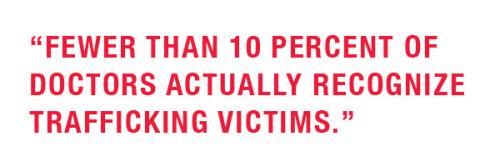
“Research tells us that fewer than 10 percent of doctors actually recognize trafficking victims, and fewer than 3 percent of ER doctors had received training in recognition and action,” Chin says. “There is a huge disparity in the number of victims seeking help and the number of doctors who could recognize them.”
Chin, the director of outreach for PATH, says the training was broken down into three distinct parts: the scope of the public health problem, how to identify a victim, and how to help or act.
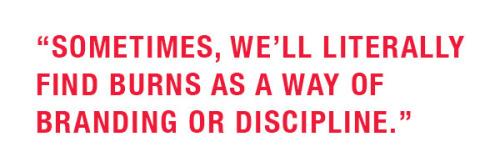
Physicians were taught how to recognize signs that a person seeking medical care is a victim. These include any of the risk factors related to background and personal history, in addition to physical evidence such as bruises, tattoos, brands and burns. “Sometimes, we’ll literally find burns as a way of branding or discipline,” says Chin, who says victims are often marked for ownership, sometimes on the face or with ink like barcodes, dollar signs and names of male captors or pimps. “You can also see signs of beating, scars, and orthopedic trauma,” he says.
Psychological signs are also common, including extreme anxiety, PTSD symptoms, anger and belligerent comments. “These victims are very mistrustful, which often puts doctors off while treating them, but it’s really a defense mechanism,” says Chin.
In terms of addressing the problem after doctors identify a victim, Chins says the path to success is less clear-cut. “There are not a lot of statistics or research on how to best help someone, because this is such an underground problem,” he says.
Related: Should A Woman Ever Need A Man’s OK To Get An Abortion?
Doctors are often face a dilemma once they suspect a patient is a victim, especially because laws in many states do not favor victims of sex trafficking. “They’ll often be arrested for prostitution if it’s reported,” Chin says. “although the laws are slowly catching up.”The New York Assembly, for instance,just passed a bill establishing stricter penalties for sex-trafficking perpetrators that gives more liberties to law enforcement officials to investigate.
By law, most doctors dealing with children have an obligation to report trafficking suspicions. However, each state has different guidelines, and it’s a tough call for docs when filing a report might put a victim in the way of more trouble. “The limitation is whether or not to report in some cases,” Chin says. “You have to balance the obligation against the doctor-patient privacy.”

However, the foundation of helping a victim is trust. “The worst thing we can do is give them a pill to pop for their problem and say they don’t need to follow up,” Chin explains. “We need to find ways to bring them back to the clinic.”
Doctors use an approach called a trauma-informed model when dealing with people who should signs of anxiety related to trauma. “Ultimately, we need to treat them as traumatized individuals with compassion, listening to them,” says Chin. “We shouldn’t be asking them ‘What’s wrong with you?’We need to ask, ‘What has happened to you?’”
What We Can Do
Chin says the March event received high praise, as doctors really do want to help in the efforts against trafficking. “We’ve had so much positive feedback,” he says. “We’ve been asked to conduct training events in other cities. We think this should be mandatory training for physicians and healthcare professionals.”
Atkinson is hopeful that more education will be required. She’s already conducted sessions on the topic at Mount Sinai’s Icahn School of Medicine, where she is a professor. “We need education for doctors, nurses, physician assistants,” she says. “Since victims are often seen in the emergency departments, in urgent cares, in ob-gyns, in dentists’ offices — the medical profession has an important role to play. They are the front lines.”
In addition, anyone can help if he or she suspects someone is a victim of trafficking. Atkinson says that people can call theNational Human Trafficking Resource Center’s anonymous hotline at 1-888-373-7888 with a tip.

Human-trafficking victims are rescued one at a time. “It’s not about saving everyone — it’s a complicated issue,” Atkinson says. “Once we get all professionals trained, it just means they have the opportunity to intervene and offer meaningful help.”
The problem is so much bigger than any one person, though; it permeates modern culture, says Atkinson. “It’s a very deep issue,” she explains. “It is about poverty, it’s about sexual exploitation, it’s about the pimping of American culture — there are so many factors.”
And while there is no quick fix, a greater awareness of the silent victims around us will help — for medical professionals, for the general public, for victims being forced into trafficking and for victims who can’t find their way out.
What can you do? As someone who has been there, Richardson provides insight. “If they are visibly being coerced, of course, continue to call the authorities to try to help them escape,” she says. “If they are now addicted to the life and are trafficking themselves, try to be a light in their life, try to speak life to them, talk them into going into treatment, speak love into them.”






























